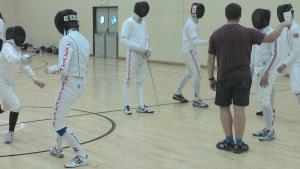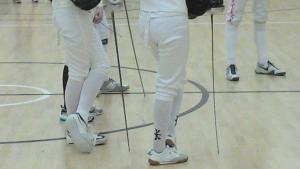Fit for fencing; part 3.
Summer training for fencers
 Sunday saw our 3rd training day of the South West Fencing Hub. The first half saw me working with the fencers in getting them ready for the summer, the second half was on coach education.
Sunday saw our 3rd training day of the South West Fencing Hub. The first half saw me working with the fencers in getting them ready for the summer, the second half was on coach education.
Traditionally, fencers take the summer off training because there are no competitions, then return to a week long camp in 6-8 weeks time, get beasted on day one and break.
Tristan Parris wants to change this, and the theme of the day was “What am I going to do this summer?” The fencers had to come up with one physical, one technical and one tactical aspect they were going to work on over the next 8 weeks.
My session was based on showing the fencers some of the exercise contained within the Sports Training System building on what they had done previously. For the first time I introduced more work capacity work based on a lateral movement circuit. I needed the fencers to know what “work” feels like.
Dynamic Posture
 Despite my best efforts, the fencers kept returning to their horrible standing postures. We have worked hard on educating them on this, and my message to the coaches was to keep reminding them about standing on two feet.
Despite my best efforts, the fencers kept returning to their horrible standing postures. We have worked hard on educating them on this, and my message to the coaches was to keep reminding them about standing on two feet.
Posture is dynamic too, and I showed them exercises in 3 different planes, working on lunging, bracing, rotating and then increasing the complexity of the movements. This included the “lunge n’ weep” series (thanks Joe P) which helps mobilise their T-spines (watch the fencing lunge n weep video).
I finished the day with a new fencing warm up sequence and a new cool down sequence. I gave co -ordination exercises, forward/ back movements and also crawling/ skipping exercises. There is more to life than two jogs around the Salle followed by some high knees/ heel flicks.
Putting the AD into LTAD
My coach education session with eight fencing coaches from around the South West was based on putting the Athletic Development into Long Term Athlete Development (available on Prezi here).
Fencing has an LTAD document which is quite weighty and dry in tone. There is a lot of good information in there, but it is hard to walk away after reading it knowing what to do in the Salle tonight. I showed the good bits and bad bits, showing where the obstacles are likely to occur.
I then showed 10 key tenets of Athletic Development that Vern Gambetta has highlighted. I gave practical examples of what this would like in the Salle. I got challenged on the late specialisation, but showed the coaches research (cf anecdotal pseudoscience by Syed, England Netball et al) that explains what it takes to get to true elite levels.
It is very important that the coaches understand the underlying principles of the work I am doing with their fencers. This is different from showing them some sexy new exercises. If they understand the principles, they are then able to implement the best routine for their fencers in their location in their circumstances.
I mixed research, practice and my own anecdotal evidence: the coaches were good at asking questions and challenging my assumptions.
Hopefully the coaches and fencers will be able to get started on the Sports Training System over the next eight weeks and start the competition season robust, efficient and fit to fence.
Further reading:
